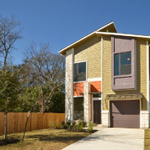How do you describe CDP’s particular niche in the development industry?
Andrew Kaye: We develop very distinctive luxury rental communities. Historically, Criterion has focused on a variety of suburban and infill markets and residential product types both in Massachusetts and Texas. In Boston, we’re currently very busy with transit-oriented infill development—primarily inside the Route 128 beltway. Our designs typically cater to very discriminating customers—renters by choice—who seek great locations in combination with distinctive design, amenities, and service. When you put all that together, it translates to great value for our customers.
Can you talk about the dynamic of working in two different geographical markets?
AK: Historically, we’ve always maintained a strong presence in both Texas and the Northeast. The two markets are driven by very different supply-and-demand fundamentals. As such, they complement each other very well. Given higher barriers to entry, more modest job growth, and more limited new supply, Boston generates fewer deals, but they can generate higher margins. Complementing those efforts, Texas may have fewer barriers to entry, but its vibrant economy can generate a lot of opportunity for great, quality development.
You’re nearing your 10-year anniversary as a company. Has your business model changed much, particularly with the economic collapse of 2008?
AK: Capital markets certainly play a big role in determining where development is focused. In 2004, when we got going, much of the development that we focused on catered to suburban submarkets and beltway employment. We’re now much more focused on higher-density urban-development opportunities that offer a variety of benefits and serve a variety of customers. For example, a number of our recent and current development projects have focused on reclaiming well-located but blighted former industrial sites. In Boston’s neighborhoods, several of these locations are situated on reclaimed urban waterways that are now valuable urban-recreation corridors. Our high-density infill projects in Medford [the Rivers Edge project], Watertown [Riverbend on the Charles], and Cambridge [Vox on Two] all have these characteristics in common and represent tremendous opportunities to create value for our residents, partners, and communities.
What was involved in the Watertown project?
AK: Watertown is a great redevelopment story. It was a boarded-up and contaminated manufacturing facility that was closed decades ago, and it’s located along the Charles River, a very historic and scenic waterway. The river’s water quality has improved markedly over the decades with environmental regulation, so remediation of this blighted site on the river and its redevelopment into a first-class residential-housing option has resulted in tremendous benefit for all involved.
So the project was intentionally located on a former brownfield site. How does CDP view this and other sustainable practices?
AK: Our residents, our capital partners, and the municipalities that we build in are all a big part of our drive toward more environmentally responsible design. Building to LEED certification standards, as well as [to]more environmentally stringent local building codes, is a big driver in our business, and we’re proud to be subscribing to many of these important initiatives. Of course, there will always be a balance between project economics and the cost of sustainability initiatives, but when economics allow, our projects and the communities that we build in are always better off for it.
What’s next for CDP?
AK: Part of our success story is that we continue to focus on what we do best, which is staying close to the deal to focus on optimal site selection, project design, and program execution. It’s a very hands-on business model, and we prefer it that way. We feel that we’re targeting a great niche right now with our focus on high-density, transit-oriented infill development. ABQ


